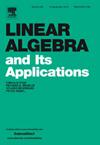The spectral radius of Steiner distance hypermatrices of graphs
IF 1.1
3区 数学
Q1 MATHEMATICS
引用次数: 0
Abstract
Let G be an n-vertex connected graph with vertex set . Given a collection of k vertices (not necessarily distinct, which can be regarded as a tuple), say , the Steiner distance is defined as the fewest number of edges in any connected subgraph of G containing all the vertices in S. The Steiner distance would be reduced to the classical distance of two vertices in the case of . Accordingly, one can generalize the distance matrix (with ) to the order-k hypermatrix, called Steiner distance hypermatrix, in which each entry is the Steiner distance of an n-dimensional array indexed by k vertices (not necessarily distinct). Very recently, Cooper and Tauscheck extended the classical Graham-Pollak theorem from the determinant of distance matrices of trees to the hyperdeterminant of Steiner distance hypermatrices of trees. In this paper, we consider the spectral radius of Steiner distance hypermatrices of general graphs, some extremal results are obtained.
图的斯坦纳距离超矩阵的谱半径
设G是一个顶点集V(G)的n顶点连通图。给定k个顶点的集合(不一定是不同的,可以看作是一个元组),假设S∈V(G)k,那么Steiner距离dG(S)定义为包含S中所有顶点的G的任何连通子图中边的最少数量。Steiner距离将被简化为k=2情况下两个顶点的经典距离。因此,可以将距离矩阵(k=2)推广为k阶超矩阵,称为斯坦纳距离超矩阵,其中每个条目是由k个顶点(不一定不同)索引的n维数组的斯坦纳距离。最近,Cooper和Tauscheck将经典的Graham-Pollak定理从树的距离矩阵的行列式扩展到树的Steiner距离超矩阵的超行列式。本文考虑一般图的斯坦纳距离超矩阵的谱半径,得到了一些极值结果。
本文章由计算机程序翻译,如有差异,请以英文原文为准。
求助全文
约1分钟内获得全文
求助全文
来源期刊
CiteScore
2.20
自引率
9.10%
发文量
333
审稿时长
13.8 months
期刊介绍:
Linear Algebra and its Applications publishes articles that contribute new information or new insights to matrix theory and finite dimensional linear algebra in their algebraic, arithmetic, combinatorial, geometric, or numerical aspects. It also publishes articles that give significant applications of matrix theory or linear algebra to other branches of mathematics and to other sciences. Articles that provide new information or perspectives on the historical development of matrix theory and linear algebra are also welcome. Expository articles which can serve as an introduction to a subject for workers in related areas and which bring one to the frontiers of research are encouraged. Reviews of books are published occasionally as are conference reports that provide an historical record of major meetings on matrix theory and linear algebra.

 求助内容:
求助内容: 应助结果提醒方式:
应助结果提醒方式:


